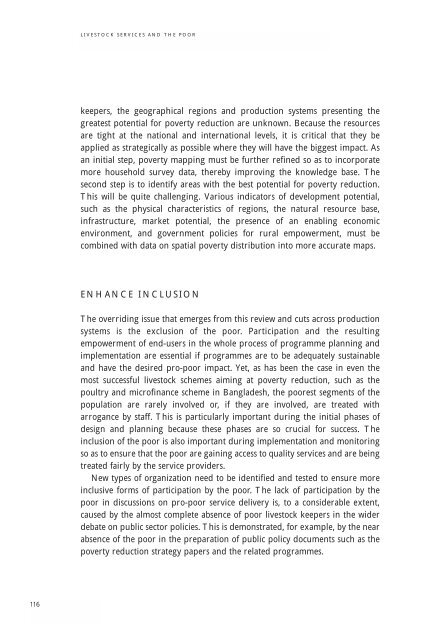Livestock Services and the Poor: A global initiative - IFAD
Livestock Services and the Poor: A global initiative - IFAD
Livestock Services and the Poor: A global initiative - IFAD
Create successful ePaper yourself
Turn your PDF publications into a flip-book with our unique Google optimized e-Paper software.
116<br />
LIVESTOCK SERVICES AND THE POOR<br />
keepers, <strong>the</strong> geographical regions <strong>and</strong> production systems presenting <strong>the</strong><br />
greatest potential for poverty reduction are unknown. Because <strong>the</strong> resources<br />
are tight at <strong>the</strong> national <strong>and</strong> international levels, it is critical that <strong>the</strong>y be<br />
applied as strategically as possible where <strong>the</strong>y will have <strong>the</strong> biggest impact. As<br />
an initial step, poverty mapping must be fur<strong>the</strong>r refined so as to incorporate<br />
more household survey data, <strong>the</strong>reby improving <strong>the</strong> knowledge base. The<br />
second step is to identify areas with <strong>the</strong> best potential for poverty reduction.<br />
This will be quite challenging. Various indicators of development potential,<br />
such as <strong>the</strong> physical characteristics of regions, <strong>the</strong> natural resource base,<br />
infrastructure, market potential, <strong>the</strong> presence of an enabling economic<br />
environment, <strong>and</strong> government policies for rural empowerment, must be<br />
combined with data on spatial poverty distribution into more accurate maps.<br />
Enhance Inclusion<br />
The overriding issue that emerges from this review <strong>and</strong> cuts across production<br />
systems is <strong>the</strong> exclusion of <strong>the</strong> poor. Participation <strong>and</strong> <strong>the</strong> resulting<br />
empowerment of end-users in <strong>the</strong> whole process of programme planning <strong>and</strong><br />
implementation are essential if programmes are to be adequately sustainable<br />
<strong>and</strong> have <strong>the</strong> desired pro-poor impact. Yet, as has been <strong>the</strong> case in even <strong>the</strong><br />
most successful livestock schemes aiming at poverty reduction, such as <strong>the</strong><br />
poultry <strong>and</strong> microfinance scheme in Bangladesh, <strong>the</strong> poorest segments of <strong>the</strong><br />
population are rarely involved or, if <strong>the</strong>y are involved, are treated with<br />
arrogance by staff. This is particularly important during <strong>the</strong> initial phases of<br />
design <strong>and</strong> planning because <strong>the</strong>se phases are so crucial for success. The<br />
inclusion of <strong>the</strong> poor is also important during implementation <strong>and</strong> monitoring<br />
so as to ensure that <strong>the</strong> poor are gaining access to quality services <strong>and</strong> are being<br />
treated fairly by <strong>the</strong> service providers.<br />
New types of organization need to be identified <strong>and</strong> tested to ensure more<br />
inclusive forms of participation by <strong>the</strong> poor. The lack of participation by <strong>the</strong><br />
poor in discussions on pro-poor service delivery is, to a considerable extent,<br />
caused by <strong>the</strong> almost complete absence of poor livestock keepers in <strong>the</strong> wider<br />
debate on public sector policies. This is demonstrated, for example, by <strong>the</strong> near<br />
absence of <strong>the</strong> poor in <strong>the</strong> preparation of public policy documents such as <strong>the</strong><br />
poverty reduction strategy papers <strong>and</strong> <strong>the</strong> related programmes.

















